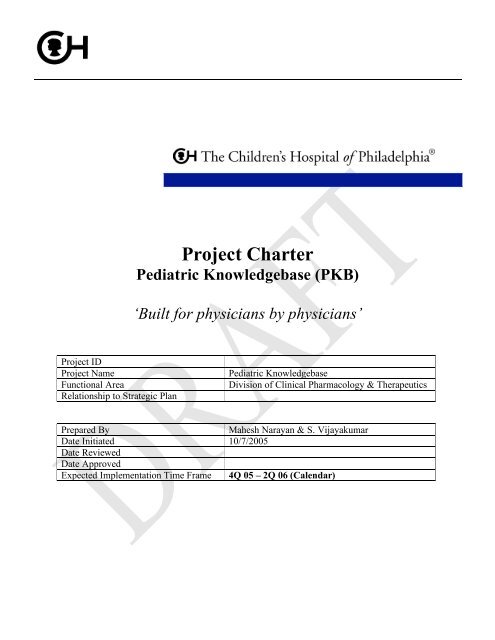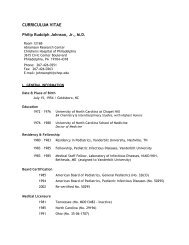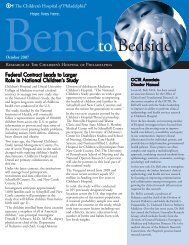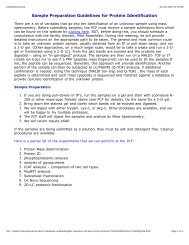Project Charter - The Children's Hospital of Philadelphia - Research ...
Project Charter - The Children's Hospital of Philadelphia - Research ...
Project Charter - The Children's Hospital of Philadelphia - Research ...
Create successful ePaper yourself
Turn your PDF publications into a flip-book with our unique Google optimized e-Paper software.
<strong>Project</strong> <strong>Charter</strong><br />
Pediatric Knowledgebase (PKB)<br />
‘Built for physicians by physicians’<br />
<strong>Project</strong> ID<br />
<strong>Project</strong> Name<br />
Functional Area<br />
Relationship to Strategic Plan<br />
Pediatric Knowledgebase<br />
Division <strong>of</strong> Clinical Pharmacology & <strong>The</strong>rapeutics<br />
Prepared By<br />
Mahesh Narayan & S. Vijayakumar<br />
Date Initiated 10/7/2005<br />
Date Reviewed<br />
Date Approved<br />
Expected Implementation Time Frame 4Q 05 – 2Q 06 (Calendar)
<strong>Project</strong> <strong>Charter</strong><br />
Table <strong>of</strong> Contents<br />
1. EXECUTIVE SUMMARY ................................................................................................................. 3<br />
2. OVERVIEW........................................................................................................................................ 3<br />
2.1. BUSINESS CASE.............................................................................................................................. 3<br />
2.2. KEY STAKEHOLDERS...................................................................................................................... 3<br />
2.3. BUSINESS REQUIREMENTS .............................................................................................................. 3<br />
2.4. PROJECT OBJECTIVES ..................................................................................................................... 4<br />
2.5. CONSTRAINTS ................................................................................................................................ 5<br />
2.6. ASSUMPTIONS ................................................................................................................................ 5<br />
2.7. RISKS ............................................................................................................................................ 5<br />
2.8. IMPACTS ........................................................................................................................................ 5<br />
3. PROJECT DESCRIPTION................................................................................................................ 6<br />
3.1. SCOPE............................................................................................................................................ 6<br />
3.1.1. IN SCOPE.................................................................................................................................... 6<br />
3.1.2. OUT-OF-SCOPE........................................................................................................................... 6<br />
3.2. MILESTONES .................................................................................................................................. 6<br />
3.3. DELIVERABLES .............................................................................................................................. 7<br />
3.4. CRITICAL SUCCESS FACTORS.......................................................................................................... 7<br />
4. ESTIMATES ....................................................................................................................................... 7<br />
5. PROJECT COMMUNICATIONS AND CONTROL ....................................................................... 8<br />
5.1. PROJECT MANAGEMENT................................................................................................................. 8<br />
5.2. PROJECT COMMUNICATIONS........................................................................................................... 8<br />
5.3. RISK MANAGEMENT....................................................................................................................... 8<br />
5.4. ISSUE MANAGEMENT ..................................................................................................................... 8<br />
5.5. CHANGE MANAGEMENT................................................................................................................. 8<br />
APPENDIX A – PROJECT COMMUNICATIONS PLAN...................................................................... 9<br />
APPENDIX B - PROJECT ROLES AND RESPONSIBILITIES ...........................................................10<br />
PROJECT DOCUMENT APPROVAL....................................................................................................11<br />
REVISION HISTORY ..............................................................................................................................12<br />
GLOSSARY OF TERMS..........................................................................................................................12<br />
© <strong>The</strong> Children’s <strong>Hospital</strong> <strong>of</strong> <strong>Philadelphia</strong> Page 2 <strong>of</strong> 2 Nov. 8, 05<br />
Confidential and Proprietary <strong>Project</strong> <strong>Charter</strong> Template v2 20050408
<strong>Project</strong> <strong>Charter</strong><br />
1. Executive Summary<br />
<strong>The</strong> Pediatric Knowledgebase (PKB) is envisioned to be a physician resource for improving<br />
pharmacotherapeutic outcomes. It is an environment to discern information about medicines prescribed in<br />
pediatrics, to tailor therapy to individual pr<strong>of</strong>ile, to forecast potential toxicity and rescue needs, to aid in<br />
understanding observed dose-response, Pharmacokinetic (PK), Pharmacodynamic (PD) data and to foster<br />
the use <strong>of</strong> clinical pharmacology in practice. <strong>The</strong> PKB will be constructed from data generated in our<br />
patients (for example, drug utilization, dosing guidance and clinical outcomes) as well as the available<br />
knowledge from various dosing compendiums, literature, and investigator-sponsored research at our<br />
institution.<br />
PKB will extend the information collected on pharmaceutical agents both inside and outside the<br />
institution to evaluate the individual therapeutic window for our patients when medicines are prescribed.<br />
Specifically, we will be able to provide expectations with respect to drug exposure, adverse events, side<br />
effects, drug interactions and clinical utility for various pediatric subpopulations in which drugs may be<br />
warranted. This project is funded through the Pediatrics Department Chair’s initiative for initial prototype<br />
development with the possibility <strong>of</strong> a non-competitive renewal for 2 additional years subject to satisfactory<br />
progress on the project deliverables.<br />
2. Overview<br />
2.1. Business Case<br />
This is a research project aimed at exploring ways to improve the quality <strong>of</strong> patient care at CHOP. A<br />
specific business case was waived for this project in lieu <strong>of</strong> the exploratory nature.<br />
2.2. Key Stakeholders<br />
Stakeholder<br />
Peter Adamson, MD<br />
Jeffrey S Barrett, PhD, FCP<br />
Mahesh Narayan, MB, MSE<br />
Sundararajan Vijayakumar, PhD<br />
Role<br />
Executive Sponsor<br />
<strong>Project</strong> Leader<br />
<strong>Project</strong> Manager - CHOP<br />
<strong>Project</strong> Manager - INTEK<br />
2.3. Business Requirements<br />
# High Level Business Requirements Alignment with Regulatory,<br />
Strategic, Tactical and/or<br />
Operational Goals*<br />
2.3.1 Create a pediatric knowledgebase for<br />
drugs in CHOP formulary from the<br />
collective experience at CHOP and share<br />
these findings on the Drug Dashboard<br />
Remarks<br />
(May include expected<br />
cost/benefit, ROI, etc)<br />
Provides comprehensive<br />
data, information and<br />
decision-analytics for the<br />
selected Drug and<br />
Disease Models<br />
(Indication) and serves<br />
as an on-line research<br />
© <strong>The</strong> Children’s <strong>Hospital</strong> <strong>of</strong> <strong>Philadelphia</strong> Page 3 <strong>of</strong> 3 Nov. 8, 05<br />
Confidential and Proprietary <strong>Project</strong> <strong>Charter</strong> Template v2 20050408
# High Level Business Requirements Alignment with Regulatory,<br />
Strategic, Tactical and/or<br />
Operational Goals*<br />
2.3.2 Provide tools to compare individual<br />
therapeutic outcomes against historical<br />
trends<br />
2.3.3 Track and trend data by multiple<br />
variables for proactive management <strong>of</strong><br />
patient care and safety<br />
2.3.4 Automatically alert key leaders <strong>of</strong><br />
potential adverse events through defined<br />
algorithms<br />
2.3.5 Develop simulation and forecasting tools<br />
for dosing guidance supported by a wellcurated<br />
reference data set combined with<br />
patient specific data<br />
<strong>Project</strong> <strong>Charter</strong><br />
Remarks<br />
(May include expected<br />
cost/benefit, ROI, etc)<br />
environment for the<br />
practicing physician<br />
Enable physician to<br />
gauge the individual<br />
therapeutic response<br />
more accurately<br />
Improve quality <strong>of</strong><br />
patient care and lower<br />
risk<br />
Avert potential adverse<br />
events (AE) and improve<br />
response to AE<br />
Personalize patient<br />
therapy<br />
2.3.6 Symptom Analyzer Aid physicians to avoid<br />
drugs with side effects or<br />
mitigate such effects by<br />
altering dose<br />
2.3.7 Medicine Selector Provide guidance to<br />
physicians to help<br />
identify the right<br />
medicine based on the<br />
patient’s condition<br />
2.3.8 Automate the interface to simulation<br />
tools so that non-expert users can<br />
generate routine forecasts by themselves<br />
2.3.9 Provide educational aids for<br />
understanding and using clinical<br />
pharmacology in routine practice<br />
Improve patient care<br />
while allowing modelers<br />
to focus on complex<br />
model development<br />
Improve resident training<br />
and promote usage by all<br />
CHOP practitioners<br />
2.4. <strong>Project</strong> Objectives<br />
<strong>The</strong> objective <strong>of</strong> this project is to fulfill the business requirements as listed above over several phases.<br />
<strong>The</strong> specific objectives targeted for phase I include:<br />
1. Define project scope<br />
2. Gather detailed requirements<br />
3. Define solution & technical architectures<br />
4. Collate and integrate necessary data from existing data stores for the two drug candidates<br />
5. Develop tools for creation <strong>of</strong> analysis-ready data for mining, querying and forecasting<br />
© <strong>The</strong> Children’s <strong>Hospital</strong> <strong>of</strong> <strong>Philadelphia</strong> Page 4 <strong>of</strong> 4 Nov. 8, 05<br />
Confidential and Proprietary <strong>Project</strong> <strong>Charter</strong> Template v2 20050408
<strong>Project</strong> <strong>Charter</strong><br />
6. Construction <strong>of</strong> individual drug platforms/interfaces defined and built by collaboration with<br />
physicians and/or therapeutic area champions, clinical pharmacologists and IT specialists<br />
7. Deliver a functional prototype by June 2006<br />
2.5. Constraints<br />
• Any necessary science (models, algorithms, or logic) required for implementation within the tools<br />
are either already available or are feasible to be developed by 2Q06<br />
• All necessary data are already collected in an electronically useable form and made available to<br />
the team<br />
• <strong>The</strong> usefulness <strong>of</strong> the tool is dependent on the availability <strong>of</strong> comprehensive sets <strong>of</strong> patient and<br />
disease management data and a close fit <strong>of</strong> modeling conditions to patient conditions. As such,<br />
PKB will only serve as a physicians’ aid and cannot recommend patient specific treatments or<br />
actions<br />
2.6. Assumptions<br />
• Physician time is available as required to develop the prototype specification<br />
• Institutional provision will be made to test the usefulness <strong>of</strong> the system in practice<br />
• All access to systems, data and other interfaces are available in a timely manner<br />
2.7. Risks<br />
<strong>Project</strong> Risk<br />
PKB’s suggestion is viewed as an<br />
authoritative answer to a specific<br />
problem<br />
<strong>The</strong> perceived impact <strong>of</strong> the project<br />
is limited to the choice <strong>of</strong> drug<br />
candidates<br />
PKB can be perceived to be a data<br />
reporting solution<br />
PKB can be perceived as a solution<br />
for all disease models and<br />
therapeutic scenarios<br />
Risk Management Strategy<br />
Educate users that PKB is only making an educated guess<br />
based on historical experience and patient pr<strong>of</strong>ile as an aid to<br />
the physician and cannot replace his/her recommendation<br />
Careful choice <strong>of</strong> the initial drug candidates for the dash<br />
board is very important not only for illustrating the value <strong>of</strong><br />
the solution but must also provide broad exposure to a large<br />
number <strong>of</strong> practicing physicians<br />
Educate users on the distinction between reporting solutions<br />
and decision support systems that distill the data to<br />
meaningful information that can guide decision<br />
Educate users on the specific capabilities and limitations <strong>of</strong><br />
PKB<br />
2.8. Impacts<br />
<strong>The</strong> project will have a significant impact on the following areas:<br />
• Improve the quality <strong>of</strong> patient care, averting or mitigating potential adverse events<br />
• Speed up physician research for broad based information, forecasting tools on selected<br />
Disease/Drug candidates<br />
• Improve the quality <strong>of</strong> resident training by making an accessible on-line research tool for<br />
exploring therapeutic options<br />
© <strong>The</strong> Children’s <strong>Hospital</strong> <strong>of</strong> <strong>Philadelphia</strong> Page 5 <strong>of</strong> 5 Nov. 8, 05<br />
Confidential and Proprietary <strong>Project</strong> <strong>Charter</strong> Template v2 20050408
<strong>Project</strong> <strong>Charter</strong><br />
3. <strong>Project</strong> Description<br />
3.1. Scope<br />
<strong>The</strong> scope <strong>of</strong> the project is to demonstrate the value <strong>of</strong> combining and incorporating historical trend<br />
analysis with modeling & simulation approaches in extending the range <strong>of</strong> therapeutic options<br />
available to a physician as well as personalizing such treatment to individual patient pr<strong>of</strong>ile, thereby<br />
improving the quality <strong>of</strong> patient care at CHOP. <strong>The</strong> merits <strong>of</strong> the proposed project will be<br />
demonstrated by, developing and making available, a functional prototype tool that will serve as a<br />
guide to the practicing physician.<br />
3.1.1. In Scope<br />
<strong>The</strong> initial prototype will focus on two (2) or three (3) selected drug candidates to illustrate value<br />
proposition as well as provide broad exposure to a large number <strong>of</strong> physicians <strong>of</strong> the potential use <strong>of</strong><br />
the proposed approaches in routine practice. As part <strong>of</strong> this effort it will include the following:<br />
3.1.1.1.Building a comprehensive and tightly integrated dataset for the selected drugs<br />
3.1.1.2.Generate analysis-ready datasets for trend analysis, modeling and simulation<br />
3.1.1.3.Develop tools to display pictorial ‘Nomograms’ for therapeutic guidance<br />
3.1.1.4.Develop tools to integrate protocol information into therapeutic guidance<br />
3.1.1.5.Develop educational aids for fostering the principles and use <strong>of</strong> clinical pharmacology<br />
3.1.1.6.Integrate modeling and simulations tools for individual and population prediction<br />
3.1.1.7.Develop and integrate AE prediction tools for individual patient<br />
3.1.1.8.Deploy prototype/tool for enterprise wide physician access<br />
3.1.2. Out-<strong>of</strong>-Scope<br />
<strong>The</strong> project scope does not include the following:<br />
3.1.2.1.Building an enterprise wide warehouse for all institutional data<br />
3.1.2.2.Develop browsing tools for warehouse data<br />
3.1.2.3.Develop disease models, simulation tools, etc.<br />
3.1.2.4.Develop new scientific methods, algorithms and/or validation tools for the same<br />
3.1.2.5.Develop data integration or automation tools for data flow<br />
3.2. Milestones<br />
Milestone<br />
Target Date<br />
Plan Kick<strong>of</strong>f 10/07/05<br />
IRB Submitted 11/1/05<br />
<strong>Project</strong> <strong>Charter</strong> Approved 11/15/05<br />
Requirements complete 12/31/05<br />
Submit Grant application to National Library <strong>of</strong> Medicine 1/31/06<br />
Approved Implementation Plan 2/15/06<br />
Non-working Prototype 3/15/06<br />
Functional Prototype 6/30/06<br />
© <strong>The</strong> Children’s <strong>Hospital</strong> <strong>of</strong> <strong>Philadelphia</strong> Page 6 <strong>of</strong> 6 Nov. 8, 05<br />
Confidential and Proprietary <strong>Project</strong> <strong>Charter</strong> Template v2 20050408
<strong>Project</strong> <strong>Charter</strong><br />
3.3. Deliverables<br />
• Non-functional application prototype – March ‘06<br />
• Functional prototype with a ‘dosing guidance dashboard’ complete for 2 target drugs – June ‘06<br />
3.4. Critical Success Factors<br />
• Selection <strong>of</strong> the right drug candidate with comprehensive monitoring data and in-house<br />
experience to validate the value proposition<br />
• Key choice <strong>of</strong> modeling and simulation tools to provide right balance between accuracy, stability<br />
and ease <strong>of</strong> use<br />
• Indexed access to available in-house data<br />
4. Estimates<br />
<strong>The</strong> resources and startup/operational costs for this project are listed below.<br />
A. Estimated Resources<br />
Resource<br />
<strong>Project</strong> Leader<br />
<strong>Project</strong> Managers<br />
<strong>Project</strong> Administrator<br />
PK/PD Modelers<br />
Clinicians<br />
Programmers<br />
CHOP IS<br />
Total Hours<br />
Estimate<br />
TBD<br />
TBD<br />
TBD<br />
TBD<br />
TBD<br />
TBD<br />
TBD<br />
Comments<br />
* Estimated Resource Total *<br />
B. Estimated Costs<br />
Type <strong>of</strong> Cost Amount Cost Center<br />
Base S<strong>of</strong>tware License<br />
TBD<br />
Interface S<strong>of</strong>tware development<br />
TBD<br />
Hardware<br />
TBD<br />
Implementation/Training<br />
TBD<br />
Maintenance/Support (annual starting year 1)<br />
TBD<br />
Other<br />
TBD<br />
* Estimated Year 1 Total *<br />
* Estimated Year 2 + Total *<br />
© <strong>The</strong> Children’s <strong>Hospital</strong> <strong>of</strong> <strong>Philadelphia</strong> Page 7 <strong>of</strong> 7 Nov. 8, 05<br />
Confidential and Proprietary <strong>Project</strong> <strong>Charter</strong> Template v2 20050408
<strong>Project</strong> <strong>Charter</strong><br />
* Is there a Capital Budget for Fiscal Year N Y/N<br />
* Is there an Operating Budget for Fiscal Year Y Y/N<br />
5. <strong>Project</strong> Communications and Control<br />
5.1. <strong>Project</strong> Management<br />
Mr. Narayan and Dr. Vijayakumar are the internal and external project managers for this project<br />
responsible for day-to-day management, conducting required meetings and ensuring the timely delivery<br />
<strong>of</strong> all milestones and deliverables as defined herein. In addition, they are responsible for identifying<br />
required resources and issues requiring management intervention and communicating them to the project<br />
leader. <strong>The</strong>y will report regular status as defined in the communication plan for distribution to the<br />
project team and stakeholders.<br />
Please refer to Appendix ‘B’ ‘<strong>Project</strong> Roles and Responsibilities’ for additional details on project<br />
organization, staffing, resource requirements, and roles and responsibilities.<br />
5.2. <strong>Project</strong> Communications<br />
<strong>Project</strong> Team meetings will be held weekly for the duration <strong>of</strong> the project. This meeting will address the<br />
project status (activities completed, planned activities for the next period, resource issues) and identify<br />
the issues requiring escalation to management. Executive Steering Committee meetings will be held on a<br />
4-6 week basis as needed to address project status, potential risks, and issues requiring management<br />
intervention. Additional details regarding project communications are included in Appendix ‘A’<br />
Communications Plan.<br />
5.3. Risk Management<br />
<strong>Project</strong> status meetings will actively monitor risks defined in Section 2.7 ‘Risks’ requiring immediate<br />
attention will be addressed based on the defined mitigation strategy. As needed, activities will be tracked<br />
by means <strong>of</strong> a project issue log. Additional needs for escalation will be identified on a case-by-case basis.<br />
5.4. Issue Management<br />
To better track and coordinate issues arising within the project, an issue-tracking log will be used. <strong>The</strong><br />
issue-tracking log will contain a description <strong>of</strong> the issue, the author <strong>of</strong> the issue, the person assigned to<br />
resolve the issue, and a target date as to when the issue should be closed.<br />
5.5. Change Management<br />
Proposed scope changes will be quantified in terms <strong>of</strong> impact to project schedule, cost and resource<br />
usage. Multiple scenarios will be explored to understand the consequences <strong>of</strong> accepting or rejecting<br />
changes in scope. An escalation procedure will be followed for any major changes to scope.<br />
© <strong>The</strong> Children’s <strong>Hospital</strong> <strong>of</strong> <strong>Philadelphia</strong> Page 8 <strong>of</strong> 8 Nov. 8, 05<br />
Confidential and Proprietary <strong>Project</strong> <strong>Charter</strong> Template v2 20050408
<strong>Project</strong> <strong>Charter</strong><br />
Appendix A – <strong>Project</strong> Communications Plan<br />
Communication/<br />
Deliverable Audience Purpose/Content<br />
Status Meeting <strong>Project</strong> working Review current<br />
team<br />
status; identify<br />
Status Meeting<br />
Minutes<br />
Issues Log<br />
<strong>Project</strong> Plan<br />
<strong>Project</strong><br />
Documentation<br />
Management<br />
Update<br />
<strong>Project</strong> working<br />
team<br />
Active<br />
participating<br />
stakeholders<br />
<strong>Project</strong> working<br />
team<br />
Reference;<br />
project archives<br />
Senior<br />
Management<br />
issues; plan<br />
Document<br />
current status;<br />
identify issues;<br />
plan<br />
Track project<br />
issues outside<br />
those captured in<br />
minutes or<br />
project plan; also<br />
address risk and<br />
change<br />
Define project<br />
tasks, milestones<br />
and schedule<br />
Detail<br />
deliverables<br />
Executive level<br />
project review<br />
Medium for<br />
Delivery<br />
Meeting/<br />
conference call<br />
Word doc via<br />
email<br />
Excel<br />
Micros<strong>of</strong>t <strong>Project</strong><br />
Word/Excel/Visio<br />
Informal<br />
presentation<br />
Frequency/<br />
Timing<br />
Weekly<br />
Weekly<br />
Weekly<br />
Weekly/<br />
As needed<br />
As needed<br />
4-6 weeks<br />
© <strong>The</strong> Children’s <strong>Hospital</strong> <strong>of</strong> <strong>Philadelphia</strong> Page 9 <strong>of</strong> 9 Nov. 8, 05<br />
Confidential and Proprietary <strong>Project</strong> <strong>Charter</strong> Template v2 20050408
<strong>Project</strong> <strong>Charter</strong><br />
Appendix B - <strong>Project</strong> Roles and Responsibilities<br />
Role<br />
<strong>Project</strong><br />
Champion/User<br />
Leader<br />
<strong>Project</strong> Leader<br />
Business Analyst<br />
<strong>Project</strong> Manager<br />
Technical <strong>Project</strong><br />
Leader<br />
Technology<br />
Architect/Lead<br />
Developer<br />
Developers<br />
Data Modeler<br />
Application<br />
Modelers<br />
<strong>Project</strong><br />
Administrator<br />
Application Tester<br />
Responsibilities<br />
• Champion for the project cause<br />
• Provide vision and guidance to the project<br />
• Ensure user needs are met<br />
• Initiate project and communicate value proposition to key stakeholders<br />
• Define scope and deliverables<br />
• Secure funding and allocate resources<br />
• Gather user requirements<br />
• Identify current workflow/dataflow processes<br />
• Define testing, validation and acceptance criteria<br />
• Coordinate user training and deployment<br />
• Responsible for day-to-day management <strong>of</strong> the project<br />
• Conduct meetings, identify and bring issues to resolution<br />
• Responsible for timely delivery <strong>of</strong> the solution within budget<br />
• Resource planning and task allocation<br />
• Report status as defined in the communication plan<br />
• Responsible for analysis <strong>of</strong> requirements<br />
• Define solution architecture<br />
• Develop specifications for solution development<br />
• Works with the solution architect and IT to identify key technologies that<br />
are suitable for building the solution<br />
• Develop pro<strong>of</strong>-<strong>of</strong>-concept prototypes to validate technology choice<br />
• Guide the developers to build the solution<br />
• Maintain code repository, versions and manage deployment<br />
• Develops and tests unit code to specification within the guidelines and<br />
standards established for the project<br />
• Analyze requirements and conceptualize the logical model<br />
• Develop physical tables, indexes and storage parameters<br />
• Responsible for creation <strong>of</strong> new PK/PD models<br />
• Identify the models/environment to be used for simulation<br />
• Validate the developed models and provide criteria for assessing the<br />
usefulness and relevance <strong>of</strong> the models<br />
• Collate and administer project documentation<br />
• Maintain versions and responsible for dissemination/distribution<br />
• Create test scripts with the technical project leader and business analyst<br />
• Execute test scripts and produce test report<br />
<strong>The</strong> Children’s <strong>Hospital</strong> <strong>of</strong> <strong>Philadelphia</strong> Page 10 <strong>of</strong> 10 9/18/2006 4:28 PM<br />
Confidential and Proprietary <strong>Project</strong> <strong>Charter</strong> Template v2 20050408
<strong>Project</strong> <strong>Charter</strong><br />
PROJECT DOCUMENT APPROVAL<br />
Sign-<strong>of</strong>f Sheet<br />
I have read the above <strong>Charter</strong> and will abide by its terms and conditions and pledge my full commitment and<br />
support for the project # - Pediatric Knowledgebase<br />
Executive Sponsor – Peter Adamson, MD – Department <strong>of</strong> Pediatrics<br />
Date<br />
<strong>Project</strong> Leader – Jeffrey S Barrett, PhD<br />
Date<br />
<strong>Project</strong> Manager - Mahesh Narayan / Sundararajan Vijayakumar<br />
Date<br />
<strong>Project</strong> Administrator – Dimple Patel<br />
Date<br />
PK/PD Modelers – Manish Gupta / John Mondick / Dominique Paccaly<br />
Physician Champions – Jeffrey Skolnik / Kelly Wade<br />
Date<br />
Programmers: BITS / INTEK Partners<br />
Date<br />
Data Modelers: Bhuvana Jayaraman<br />
Date<br />
<strong>The</strong> Implementation Plan is estimated to be completed and approved by January 31, 2006.<br />
<strong>The</strong> Children’s <strong>Hospital</strong> <strong>of</strong> <strong>Philadelphia</strong> Page 11 <strong>of</strong> 11 9/18/2006 4:28 PM<br />
Confidential and Proprietary <strong>Project</strong> <strong>Charter</strong> Template v2 20050408
<strong>Project</strong> <strong>Charter</strong><br />
Revision History<br />
Date Version Description <strong>of</strong> Modification Author<br />
10/7/2005 0.1 Create Document Mahesh Narayan<br />
11/1/2005 0.2 Modify Document S. Vijayakumar<br />
11/8/2005 0.3 Incorporate team comments S. Vijayakumar &<br />
Mahesh Narayan<br />
Glossary <strong>of</strong> Terms<br />
Acronym<br />
PKB<br />
CPT<br />
PK<br />
PD<br />
Description<br />
Pediatric Knowledgebase<br />
Clinical Pharmacology & <strong>The</strong>rapeutics<br />
Pharmacokinetics<br />
Pharmacodynamics<br />
<strong>The</strong> Children’s <strong>Hospital</strong> <strong>of</strong> <strong>Philadelphia</strong> Page 12 <strong>of</strong> 12 9/18/2006 4:28 PM<br />
Confidential and Proprietary <strong>Project</strong> <strong>Charter</strong> Template v2 20050408






